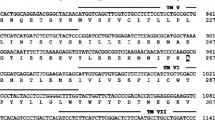Abstract
Peptide hormones depend on reliable recognition by their receptors. Any mutation that compromises recognition of hormone and receptor molecules is dangerous, the carrier animal would not procreate and the mutation would be lost. Although, most of the hormones from one mammalian species are active when injected into another, the incompatibility of human GH receptor toward nonprimate GHs is a notable exception. It is reported that the coevolution of GH and GHR in primates includes two crucial steps (Mol. Biol. Evol. 18 (2001) 945). The first was mutation of GH His→Asp at position 171 that happened before the split of Old world and New world monkeys. The second event was Leu→Arg change at position 43 in the GH receptor molecule that happened in the ancestor of Old world monkeys. The proposed model is based on the possibility that certain mutations can modify the surface of one of interacting molecules to form a confined empty space, a niche in the otherwise congruent hormone/receptor interface. Altoough affinity between molecules is probably slightly reduced, recognition and function are not compromised in this special case. Further mutations of hormone and receptor molecules are allowed under the condition that they remain confined to the niche space. Mutations that do not compromise hormone function can be passed to offsprings. If the consequent mutation of one molecule change its shape to fill the niche space, further mutations without function loss will become less probable. Without the niche space, the phase of fast evolution is closed and both genes become conserved. In this setting, accumulated mutations before the niche closing mutation are the cause of species specificity. To become a dominant variety, carrier animals must possess survival advantage in comparison to the carriers of other less advantageous mutations.
Similar content being viewed by others
References
Carr, D., Friesen, H.G., 1976. Growth hormone and insulin binding to human liver. J. Clin. Endocrinol. Metab. 42, 484–493.
Horrobin, D., 2001. The Madness of Adam and Eve. Corgi Books, London, p. 67.
Liu, J.C., Makova, K.D., Adkins, R.M., Gibson, S., Li, W.H., 2001. Episodic evolution of growth hormone in primates and emergence of the species specificity of human growth hormone receptor. Mol. Biol. Evol. 18, 945–953.
Wallis, M., 1994. Variable evolutionary rates in the molecular evolution of mammalian growth hormones. J. Mol. Evol. 38, 619–627.
Yi, S., Bernat, B., Pal, G., Kossiakoff, A., Li, W.H., 2002. Functional promiscuity of squirrel monkey growth hormone receptor toward both primate and nonprimate growth hormones. Mol. Biol. Evol 19, 1083–1092.
Author information
Authors and Affiliations
Corresponding author
Rights and permissions
About this article
Cite this article
Kurbel, S., Gulam, D., Kovačić, D. et al. Mutations that modulate receptor-hormone congruency as a cause of the primate GH receptor species specificity. Theory Biosci. 123, 435–440 (2005). https://doi.org/10.1016/j.thbio.2004.10.004
Received:
Accepted:
Issue Date:
DOI: https://doi.org/10.1016/j.thbio.2004.10.004




